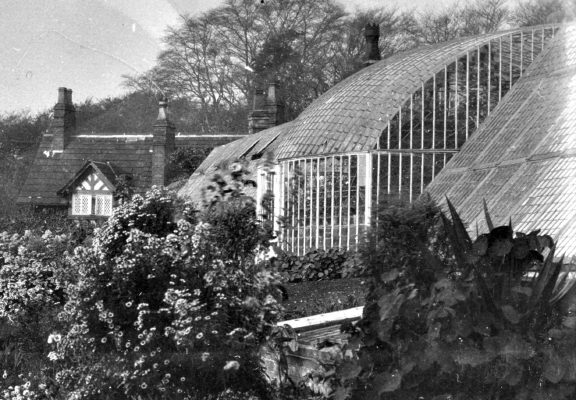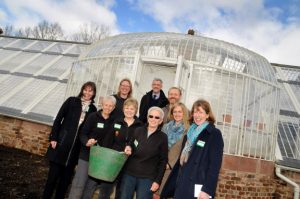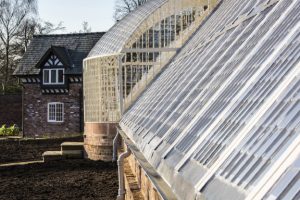- Home
- News
- What’s On
- Activities for Children
- Arts & Crafts
- Autos and Bikes
- Business events
- Car Boot & Auctions
- Charity events
- Churches & Religious
- Comedy
- Dance
- Days out & Local interest
- Education
- Exhibition
- Film
- Gardening & Horticulture
- Health
- Markets & Fairs
- Music
- Nature & Environment
- Spiritual
- Sport
- Talks and Discussions
- Theatre and Drama
- Business
- Local Information
- Jobs
- Deaths
- Charity events
- Contact Us
Quarry Bank glasshouse restored to its former glory

Above: The black and white picture shows the glasshouse in its heyday while the image below shows how it looks newly restored.
A rare example of a 19th century curvilinear glasshouse has been restored at the National Trust’s Quarry Bank in Cheshire after a year-long restoration project.
The 1820s glasshouse was built to supply the owners of Quarry Bank mill, the Greg family, with tender fruit of the time, such as grapes and peaches.
Its innovative design and use of modern technology sent a clear message to guests about the Gregs’ financial success and position in society.

Looking up in the curvilinear section of the glasshouse – the ability to purchase this much glass was a statement of the Greg family’s wealth when the glasshouse was built – (c) Nick King
Although the conservation charity acquired the 18th century cotton mill in 1939, it was only in 2010 that the kitchen garden was acquired by the Trust. The jewel in the crown of this walled garden was the severely damaged curvilinear glasshouse, a name given to the structure because of its unique curved roof.
Eleanor Underhill, Quarry Bank’s general manager, said: “We knew that we had something special here and that hidden under years of decay and old corrugated sheeting was a remarkable glasshouse which had stood derelict for many years.
“We carried out archaeological, structural and historic research into the building which revealed that it is one of the earliest curvilinear hot houses in the country. We knew then that we had to save it.”
Results from the survey along with photographs, letters, diaries, maps and garden plant orders from Quarry Bank’s extensive archives, provided the team with an opportunity to accurately restore the glasshouse to its former glory and understand more about the purpose of its design.
The expensive cast iron frame was created to strengthen the glasshouse’s structure and provide the opportunity for an innovative domed roof to be used.
This high roof allowed for the cultivation of palms and other large exotic specimens, which had newly arrived in the country via the exploits of plant hunters travelling the world.
Carefully controlled heating conditions allowed the gardening team to grow delicate fruits for the mill’s owners, the Greg family.
Keeping these fragile plants alive required constant tending and clever technology. Boys as young as nine were charged with keeping the glasshouse’s boiler working 24 hours a day.
In autumn 2015 the damaged cast iron frame was carefully dismantled before being taken to a workshop where, over six months, engineers from Dorothea Restorations carried out painstaking work to make repairs and identify missing pieces of the structure.
On site, Armitage Construction repaired the brick and stone walls for the return of the frame and the chimneys were rebuilt.
Glass had to be mouth-blown into 50cm long cylinders, which were then cut in half to create more than 7,500 panes of glass.

Members of the Quarry Bank team including volunteers as well as representatives from major supporters of the project including the Heritage Lottery Fund and Wolfson Foundation.
Sarah Witts, Quarry Bank’s head gardener, said: “Seeing the glasshouse restored to its former glory is a real delight. It is such a unique structure and tells us a lot about the lives of the Greg family and the luxuries they would have enjoyed compared with the mill workers.
“With our newly installed biomass boiler, we’ll be able to heat sections of the glasshouse so that exotic plants such as orchids and palms along with fruits including grapes and peaches that the Gregs would have enjoyed, can once again be grown here.”
As well as the glasshouse, the adjoining back sheds that were once the potting area for the estate’s gardeners and the location of the boilers, have been restored.
Archive material revealed that two of the Greg family children also used the space to create a small museum where they would display the treasures that they had found across the estate.
Now, the National Trust has used these stories as the inspiration for its interpretation of the space.
These ‘interactive potting sheds’ will allow visitors to discover the story of the people who cared for the garden.
With displays telling the stories of Quarry Bank’s gardeners and a mini museum filled with curious finds, there will be something for everyone to enjoy.
The restoration of the glasshouse is part of a major four year, £9.4 million project to transform Quarry Bank and reflect its position as a rare survival of a complete industrial community, funded by the Heritage Lottery Fund, the Wolfson Foundation and other generous organisations and individuals.


You must be logged in to post a comment Login